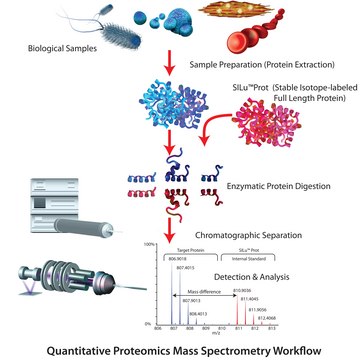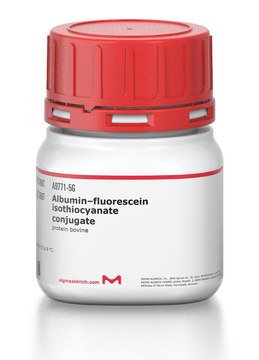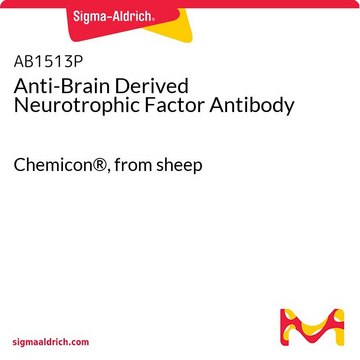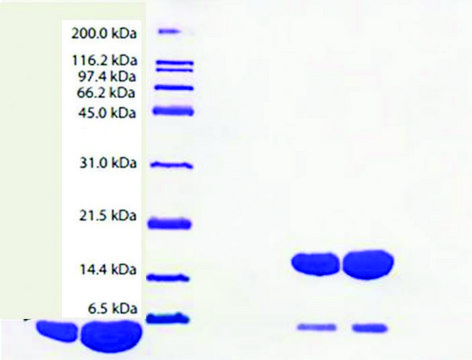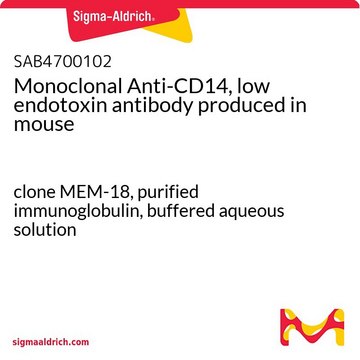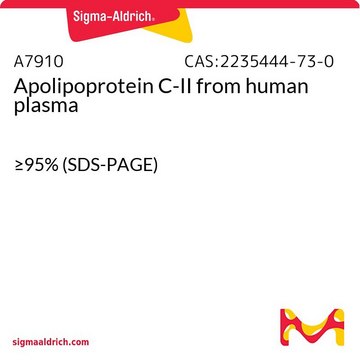SRP4326
Apo-D human
recombinant, expressed in E. coli, ≥95% (SDS-PAGE), ≥95% (HPLC)
Synonym(s):
ApoD, Apolipoprotein D
Sign Into View Organizational & Contract Pricing
All Photos(1)
About This Item
Recommended Products
biological source
human
recombinant
expressed in E. coli
Assay
≥95% (HPLC)
≥95% (SDS-PAGE)
form
lyophilized
mol wt
~20 kDa
packaging
pkg of 10 μg
storage condition
avoid repeated freeze/thaw cycles
impurities
endotoxin, tested
NCBI accession no.
UniProt accession no.
shipped in
wet ice
storage temp.
−20°C
Gene Information
human ... ApoD(347)
General description
Apolipoprotein D (APOD) is encoded by the gene mapped to human chromosome 3q29. The encoded protein is ubiquitously expressed in the body, but at high levels in glial cells of the brain, fibroblasts, spleen, testes and mammary cysts. APOD is a lipocalin containing an eight-stranded antiparallel β-sheet barrel-like structure forming a hydrophobic pocket.
Apolipoprotein-D (Apo-D) is mainly associated with high density lipoproteins in human plasma. It is expressed in numerous tissues having high levels of expression in spleen, testes and brain. Apo-D is a multi-ligand, multi-functional transporter and transports a ligand from 1 cell to another within an organ, scavenge a ligand within an organ for transport to the blood or could transport a ligand from the circulation to specific cells within a tissue. The recombinant human Apo-D expressed from E. coli is a single, non-glycosylated, Polypeptide chain containing 174 amino acids and having a molecular mass of 19.8 kDa.
Biochem/physiol Actions
Apolipoprotein D (APOD) plays an essential role in the development and repair of the brain and protection from oxidative stress. In addition, it also plays an essential role in lipid metabolism by facilitating the binding of HDL (high density lipoprotein) to LDL (low density lipoprotein) and to grow T24 carcinomas. Variation in the APOD expression acts as a genetic marker for obesity and several components of syndrome X.
Physical form
Lyophilized from 1 mg/ml in 4 mM KH2PO4, 16 mM Na2HPO4 and 115 mM NaCl pH7.5.
Reconstitution
Centrifuge the vial prior to opening. Avoid freeze-thaw cycles.
Reconstitute in dH2O to a working volume of 0.5 mg/mL and let the lyophilized pellet dissolve completely. This solution can then be diluted into other aqueous buffers and stored at 4°C for 1 week or –20°C for future use.
Storage Class Code
13 - Non Combustible Solids
WGK
WGK 3
Flash Point(F)
Not applicable
Flash Point(C)
Not applicable
Regulatory Information
新产品
Choose from one of the most recent versions:
Certificates of Analysis (COA)
Lot/Batch Number
Don't see the Right Version?
If you require a particular version, you can look up a specific certificate by the Lot or Batch number.
Already Own This Product?
Find documentation for the products that you have recently purchased in the Document Library.
ApoD Mediates Binding of HDL to LDL and to Growing T24 Carcinoma
Braesch-Andersen S, et al.
PLoS ONE, 9(12), e115180-e115180 (2014)
Quantitative-Trait Loci Influencing Body-Mass Index Reside on Chromosomes 7 and 13: The National Heart, Lung, and Blood Institute Family Heart Study
Feitosa M F, et al.
American Journal of Human Genetics, 70(1), 72-82 (2002)
Emilie Picard et al.
Molecular vision, 14, 928-941 (2008-05-30)
Transferrin (Tf) expression is enhanced by aging and inflammation in humans. We investigated the role of transferrin in glial protection. We generated transgenic mice (Tg) carrying the complete human transferrin gene on a C57Bl/6J genetic background. We studied human (hTf)
Apolipoprotein-D polymorphism: a genetic marker for obesity and hyperinsulinemia.
Vijayaraghavan S, et al.
The Journal of Clinical Endocrinology and Metabolism, 79(2), 568-570 (1994)
Our team of scientists has experience in all areas of research including Life Science, Material Science, Chemical Synthesis, Chromatography, Analytical and many others.
Contact Technical Service